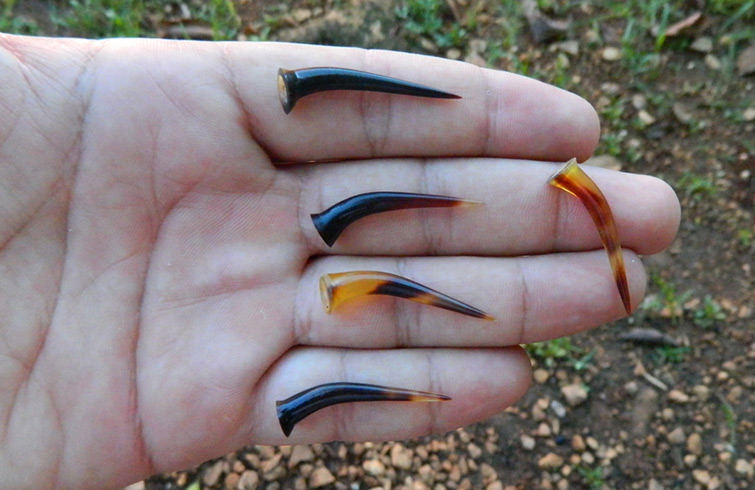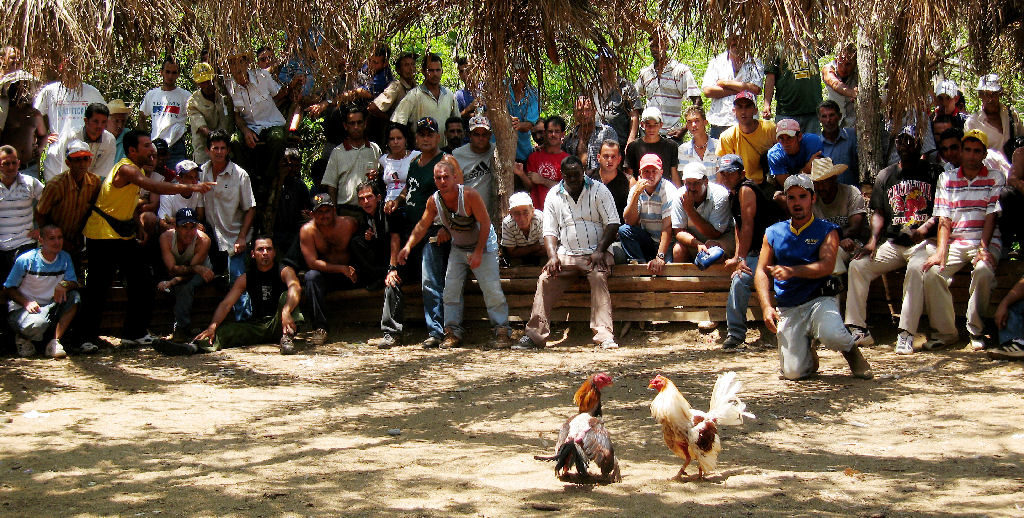The breeding and fighting of fine roosters in Cuba is much more than a sport or fertile ground for bettors: it is, in essence, a way of life and the most deeply rooted tradition in the Cuban countryside, so deeply rooted that in the country the duels of Roosters are totally legal. The illegal is the world generated around the fence.
El Chino is now 48 years old and he has more than 40 years of activity, for him, he confesses with pride, roosters are a fundamental part of his life. After so much time in the town, everyone respects their criteria on the subject and, without being a professional bartender, is one of the
men who know more about the matter and those who have had more luck in the fences.
“It’s about many details, because they are very delicate animals in their upbringing and preparation. That’s why someone who is dedicated to it full-time is needed, “he explains. There are three fundamental races in Cuba today: the Gallo Gaucho Oriental (also called Argentino), the Corner and the Criollo, which is the most traditional and comes from the 19th century with the mambises.
Already after seven or eight months the rooster is sent to a gallery where it is prepared for at least three months with training sessions, adequate meals and at regular hours. There they also crash, both below and above the back, “not only by tradition, but because the roosters pay more in the fights,” says El Chino.
The fights take place in state or clandestine fences, these last places that everyone knows and very few bother. The legal locations, some of them very famous as Alcona -located on the outskirts of the Cuban capital and endorsed by the Commander of the
Guillermo García Revolution -, are leisure places run by Cuban institutions that have built a whole world around the fights.
There they measure their roosters those associated with the fence, who do not pay entry and usually have two copies on each date. But in the state fences the action is not constant, with peaks of activity from the last fortnight of December until the middle of August
of the following year.
On the other hand, the private palenques are in the mountain, apparently hidden although they are not bothered by the police. In those sites have also generated offers to satisfy the regulars: lunches, sale of souvenirs and what you can imagine. These billboards usually get their income from the tickets, which range between 60 and 80 pesos (about $ 3) per person.
In both locations the passion for roosters and bets is shared, which is an accepted phenomenon. In Cuba, the illegal is not the cockfight itself, but to bet; however, those in charge of the premises only ask for discretion from the players. It is inevitable and in some places up to 200 thousand pesos (about $ 8,000) per fight. However, El Chino says that no one talks about illegal gambling, and nobody prevents them either. “I have fought mine for up to 20 thousand pesos,” he explains.
But the money – so much money – also carries the risk of the trap disguised as poison and drugs in the spurs (untura). To counter this, there are laboratories in the fence of Alcona, according to El Chino, but in the mountain the solution was to appoint a person to clean the spurs and take the rooster. Of course, the culture of the roosters in Cuba is strict on this issue and the respectful bouncers despise cheaters for tarnishing the good name of this practice.
“Between us the trap is not conceived, at least not among those who have devoted their whole lives to raising roosters. Nor is it usual, that usually happens in fences of little respect to where unscrupulous people go to earn four pesos “, emphasizes El Chino visibly
angry about the subject
By unpredictable and beautiful, the rooster has found in the Cuban fields a cultural foothold impossible to break. Perhaps that is why it is allowed, even though everyone knows that it generates bets and that a microcosm has been built around it that lives expectantly on the edge of the fence.
CRIA Y PELEAS DE GALLOS FINOS EN CUBA: UNA TRADICIÓN NACIONAL.
La cría y pelea de gallos finos en Cuba es mucho más que un deporte o tierra fértil para los apostadores: es, en esencia, un estilo de vida y la más arraigada tradición en el campo cubano, tan arraigada que en el país los duelos de gallos son totalmente legales. Lo ilegal es el mundo generado alrededor de la valla.
https://youtu.be/JMeTk4l2HBk
El Chino ya cumplió 48 años de edad y lleva en este ajetreo más de 40, para él —lo confiesa con orgullo— los gallos son parte fundamental de su vida. Después de tanto tiempo en el pueblo todos respetan sus criterios sobre el tema y, sin ser gallero profesional, es uno de los
hombres que más conoce del asunto y de los que más suerte ha tenido en las vallas.
“Se trata de muchos detalles, pues son animales muy delicados en su crianza y preparación. Por eso es necesario alguien dedicado a ello a tiempo completo”, explica. Existen hoy en Cuba tres razas fundamentales: el Gallo Gaucho Oriental (también llamado Argentino), el Corner y el Criollo, que es el más tradicional y viene desde el siglo XIX con los mambises.
Ya a partir de los siete u ocho meses el gallo se envía a una gallería donde es preparado durante al menos tres meses con sesiones de entrenamiento, comidas adecuadas y a horas regulares. Allí también se tusan, tanto por debajo como por encima del lomo, “no se hace solo por tradición, sino porque así los gallos rinden más en las peleas”, asegura El Chino.
Las peleas se efectúan en vallas estatales o clandestinas, sitios estos últimos que todo el mundo conoce y muy pocos molestan. Las locaciones legales, algunas de ellas muy famosas como Alcona —ubicada en las afueras de la capital cubana y avalada por el Comandante de la
Revolución Guillermo García—, son plazas de esparcimiento regenteados por instituciones cubanas que han construido todo un mundo alrededor de las peleas.
Allí miden sus gallos los asociados a la valla, quienes no pagan entrada y generalmente presentan dos ejemplares en cada fecha. Pero en las vallas estatales la acción no es constante, con picos de actividad a partir de la última quincena de diciembre hasta mediados de agosto
del año siguiente.

Espuelas: A los gallos se les ponen espuelas de carey para que hagan más daño a su contrincante / Foto: Julio Batista.
Por otra parte, los palenques particulares están en el monte, aparentemente escondidos aunque no son molestados por la policía. En esos sitios también se han generado ofertas para satisfacer a los asiduos: almuerzos, venta de suvenires y de cuanto se pueda imaginar. Estas vallas generalmente obtienen sus ingresos a partir de las entradas, que oscilan entre los 60 y 80 pesos (unos 3 dólares) por persona.
En ambas locaciones se comparte la pasión por los gallos y las apuestas, que constituyen un fenómeno aceptado. En Cuba lo ilegal no es la pelea de gallos en sí, sino apostar; sin embargo, quienes están al frente de los locales solo piden discreción a los jugadores. Se trata de algo inevitable y en algunos sitios llegan hasta los 200 mil pesos (unos 8000 dólares) por pelea. No obstante, asegura El Chino que allí nadie habla de apuestas ilegales, y tampoco nadie las impide. “Yo mismo he peleado los míos hasta por 20 mil pesos”, explica.
Pero el dinero —tanto dinero— también trae el riesgo de la trampa disfrazada de veneno y medicamentos en las espuelas (untura). Para contrarrestar esto, en la valla de Alcona existen laboratorios según explica El Chino, pero en el monte la solución fue designar a una persona para que limpie las espuelas y dé de tomar al gallo. Eso sí, la cultura de los gallos en Cuba es estricta en este tema y los galleros de respeto desprecian a los tramposos por empañar el buen nombre de esta práctica.
“Entre nosotros no se concibe la trampa, al menos no entre quienes se han dedicado toda la vida a criar gallos. Tampoco es lo usual, eso generalmente pasa en vallas de poco respeto a donde van gente sin escrúpulos para ganarse cuatro pesos”, enfatiza El Chino visiblemente
enfadado por el tema.
Por impredecible y bello, el gallo ha encontrado en los campos cubanos un asidero cultural imposible de romper. Quizás por eso sea permitido, a pesar de que todos conocen que genera apuestas y que a su alrededor se ha construido un microcosmos que vive expectante a la orilla de la valla.
Agencies/OnCuba/Julio Batista/Internet Photos/YouTube/ Arnoldo Varona/ TheCubanHistory.com
THE CUBAN HISTORY, HOLLYWOOD.



 > RAISING AND FIGHTING of Fine Roosters in Cuba: A National Tradition. (Video/Photos). <> CRIA Y PELEAS DE GALLOS Finos en Cuba:Una Tradición Nacional. (Video).
> RAISING AND FIGHTING of Fine Roosters in Cuba: A National Tradition. (Video/Photos). <> CRIA Y PELEAS DE GALLOS Finos en Cuba:Una Tradición Nacional. (Video).





